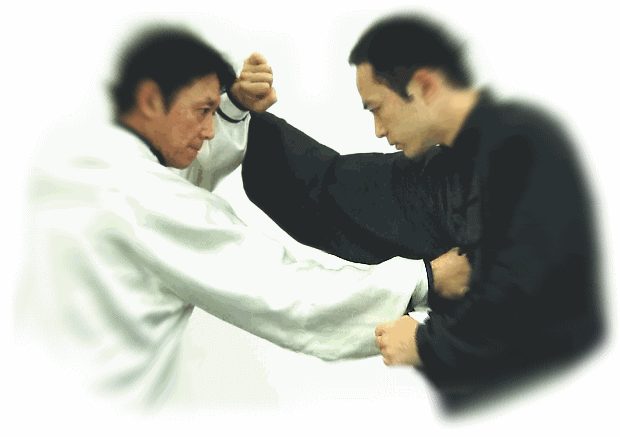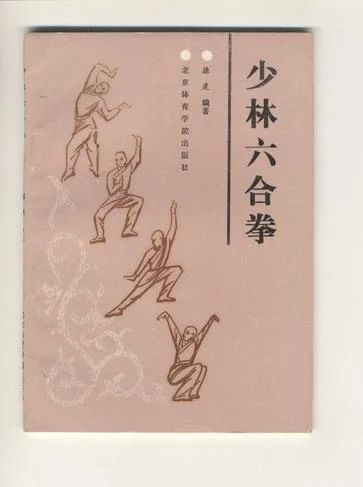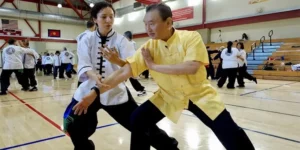
Six Harmonies Quan (Liuhe Boxing) is a traditional Chinese martial art originating from Shaolin Temple during the late Yuan/early Ming Dynasty (14th century). The “Six Harmonies” refer to coordinating six spatial dimensions (north/south/east/west/up/down), unifying:
- Hands & Eyes
- Footwork & Body
- Wisdom & Strength
Training System:
Practitioners emulate five animal forms through Bagua (Eight Trigram) footwork:
- Dragon’s fluid movements
- Tiger’s commanding stillness
- Crane’s graceful lightness
- Rabbit’s rapid transitions
- Monkey’s agile maneuvers
Combat Focus:
- Striking techniques
- Joint-locking
- Throwing skills
Performance Characteristics:
Aesthetic yet practical stances combining:
- Powerful postures
- Swift dodging (Shan Zhan Teng Nuo)
- Dynamic speed variations
Recognized in 2011 as China’s National Intangible Cultural Heritage (Third Batch), Cangzhou-style Liuhe Quan preserves this rare Shaolin legacy.
Basic Information of Xinyi Liuhe Quan (6 Harmonies Quan)
Origin period: originated in the late Yuan and early Ming dynasties (mid-14th century)
Creator: Monk Xu Naluo, a fire-tending monk of Shaolin Temple
Basis of creation: adapted from various combat techniques used in daily monastic self-defense
Characteristics:
- Structured and systematic techniques
- Balanced offense and defense
- Highly practical for real combat
Combat strategy: focuses on encirclement, obstruction, interception, and destabilizing the opponent’s stance
Style classification: blends elements of both internal (Neijia) and external (Waijia) martial arts
Martial category: evolved as a branch of Shaolin Kung Fu, classified under external styles
Type of martial art: traditional Chinese boxing
What is Xinyi Liuhe Quan?
According to Chinese folklore, Six Harmonies Boxing (Liuhe Quan) originated during the late Yuan Dynasty and early Ming Dynasty (14th century). Legend attributes its creation to Xu Naluo, a fire-tending monk of Shaolin Temple, who developed it by incorporating practical combat techniques used in daily monastic fighting.
Characteristics
- Structured & Disciplined – Balanced footwork, precise strikes, and controlled movements
- Offense & Defense Integration – Seamless transitions between attacking and blocking
- Realistic & Practical – Highly effective for actual combat scenarios, making it a favorite among warrior monks
- Versatile Combat Style – Adaptable to different fighting situations

Training & Application
As a fundamental paired combat routine (对练套路) in Shaolin Kung Fu, Liuhe Quan has been a core training method for generations, crucial for preparing monks for martial arts competitions (打擂).
Combat Strategy
- Key Tactics: Encircle (围), Block (拦), Intercept (截), and Disrupt (卡) the opponent’s stance (外盘)
- Core Techniques: Grappling (刁、捋、带), Striking (挑、崩、劈、砸), Kicking (踢、蹬), and Throws (摔、拿)
- Fighting Philosophy: “Defense as attack, attack as defense” — fluid changes between guarding and striking, adaptable to any combat angle
Movement & Flow
- Expansive yet Compact: Broad, open strikes transition smoothly into tight, controlled motions
- Dynamic Rhythm: Alternates between fast and slow, hard and soft, combining explosive power with graceful movements
- Breath & Energy Coordination: Builds internal strength (刚柔相济) while enhancing agility
Benefits
- Self-Defense: Effective for real-world combat
- Health & Fitness: Improves strength, flexibility, and mental focus
Liuhe Quan Properties

Inner & Outer Harmony in Training
Six Harmonies Boxing integrates the principles of “Internal Three Harmonies” (内三合) and “External Three Harmonies” (外三合), making it a rare style that blends both internal (Neijia) and external (Waijia) martial arts.
Historical Perspectives
- Traditional Folk Classification:
- Regarded as an “external style” (外家拳) (as per Mr. Xu Yusheng)
- Considered an evolution of Shaolin Kung Fu, reflecting its combat-focused roots
- Lineage & Schools:
- A branch of the Weituo Sect (韦陀门) within Northern Shaolin (as recorded by Mr. Wan Laisheng)
- Modern Classification (Post-1949 China):
- Officially categorized as a Long Fist (Chang Quan) style under traditional Chinese martial arts by national sports authorities
Technical Summary
- Blends Internal & External:
- Internal (Neijia) — Cultivates mind-breath-body alignment (内三合: 心与意合, 意与气合, 气与力合)
- External (Waijia) — Emphasizes coordinated limb movements (外三合: 手与足合, 肘与膝合, 肩与胯合)
- Combat & Aesthetics:
- Exhibits classic Long Fist traits: extended postures, fluid combinations, and dynamic footwork
- Retains Shaolin practicality with direct strikes, throws, and joint locks
Liuhe Defination and Explanation
The name “Liuhe” (六合, Six Harmonies) originates from three fundamental interpretations:
- Six Directions of Nature (自然界六方) — East, West, South, North, Up, Down (东、西、南、北、上、下)
- Six Body Parts (人体六部) — Hands, Feet, Elbows, Knees, Shoulders, Hips (手、足、肘、膝、肩、胯)
- Internal & External Coordination (内外三合) — The core concept of martial harmony between mind, energy, and movement
1. Internal Three Harmonies (内三合)
- Heart & Intent Unify (心与意合) — The mind’s focus aligns with conscious intent, manifesting as sharp awareness (e.g., a cat stalking prey, an eagle seizing a rabbit).
- Intent & Qi Unify (意与气合) — Mental focus activates deep breathing, stimulating circulation, warming the dan tian (脐下丹田), generating internal power.
- Qi & Power Unify (气与力合) — Breath directs force, turning intention into explosive strikes—“Yi leads Qi, Qi drives power.”
2. External Three Harmonies (外三合)
- Hands & Feet Sync (手与脚合)
- Elbows & Knees Sync (肘与膝合)
- Shoulders & Hips Sync (肩与胯合)
Result: Total body unity—no wasted motion, optimal balance, and precision.
The Essence of “Harmony” (合) in Martial Movement
“He” (合) is natural bodily intelligence—humans inherently move in coordinated ways:
- When stepping forward, the opposite arm swings back.
- Pushing forward engages the legs driving back.
- Exhaling powers strikes; inhaling stores energy.
Martial “Harmony” Extends Beyond Six Pairings:
- Internal/External (内合外合)
- Upper/Lower Body (上下相合)
- Left/Right Balance (左右相合)
- Forward/Backward Flow (前后相合)
Achieving True “Six Harmonies” in Combat
- Feet Root → Legs Drive → Hips Torque → Waist Rotates → Shoulders Project → Hands Release — This chain creates the “Six Harmonies Power” (六合劲).
- Example: A punch isn’t just arm strength—rear foot presses, knee extends, hip twists, waist coils, shoulder thrusts, fist pierces—all in one fluid motion.
Common Mistakes: Beginners tense up, disrupting natural harmony. The key is to “move like nature” (拳打自然)—relaxed yet explosive, intentional yet instinctive.
There are so much more to talk about Xinyi Liuhe Quan. If you’re interested in learning shaolin kung fu, please contact us now!



